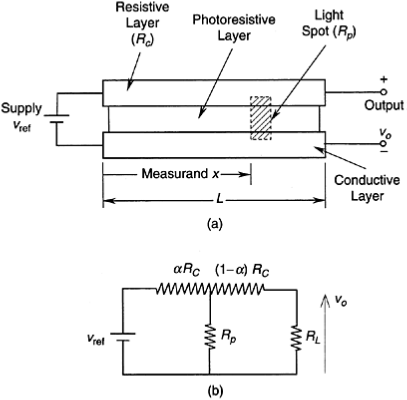SKEDSOFT
Optical Potentiometer
The optical potentiometer is a displacement sensor. A layer of photoresistive material is sandwiched between a layer of ordinary resistive material and a layer of conductive material. The layer of resistive material has a total resistance of RC, and it is uniform (i.e., it has a constant resistance per unit length). This corresponds to the coil resistance of a conventional potentiometer.
The photoresistive layer is practically an electrical insulator when no light is projected on it. The displacement of the moving object (whose displacement is being measured) causes a moving light beam to be projected on a small rectangular area of the photoresistive layer.
This light-activated area attains a resistance of Rp, which links the resistive layer that is above the photoresistive layer and the conductive layer that is below the photoresistive layer. The supply voltage to the potentiometer is uref, and the length of the resistive layer is L.
The light spot is projected at a distance x from one end of the resistive element, as shown in the figure. An equivalent circuit for the optical potentiometer.
Here it is assumed that a load of resistance RL is present at the output of the potentiometer, voltage across which being uo. Current through the load is uo/RL.

(a) An optical potentiometer, (b) Equivalent circuit (a=x/L)